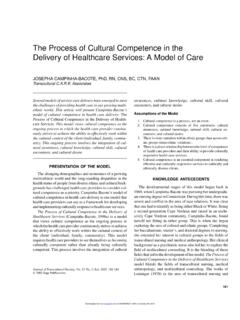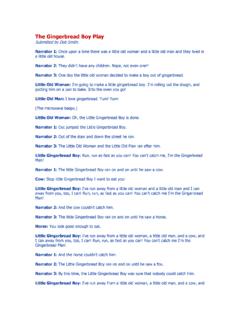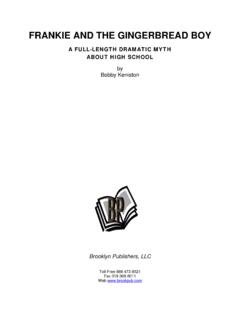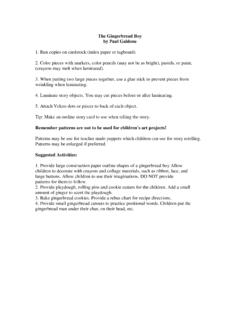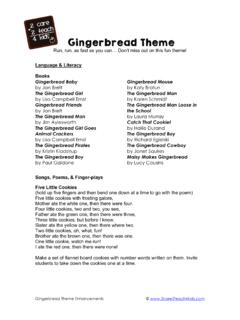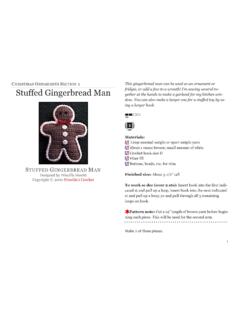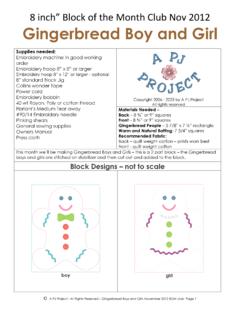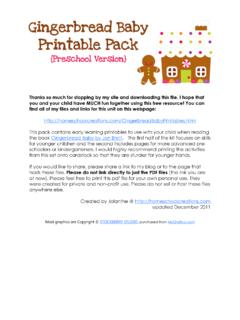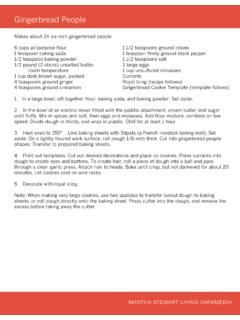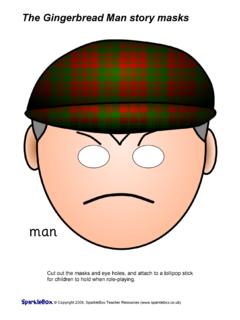Transcription of “The Gingerbread Boy” Read Aloud - Ram Pages
1 The Gingerbread Boy read Aloud Purpose: It is important to conduct this lesson because it will model fluent reading to the students while expanding their vocabulary. This lesson focuses on sequencing and requires the students to remember the order of a series of events. This lesson also allows the students to practice using comprehension strategies. Reading Aloud to students has been proven to motivate them to want to read . This lesson targets the VA English SOL : The student will demonstrate comprehension of fictional texts. a) Identify what an author does and what an illustrator does.
2 B) Relate previous experiences to what is read . c) Use pictures to make predictions. d) Begin to ask and answer questions about what is read . e) Use story language in discussions and retellings. f) Retell familiar stories, using beginning, middle, and end. g) Discuss characters, setting, and events. Objectives: The students will demonstrate comprehension of the text The Gingerbread Boy through predicting. During the reading, the students will be able to record a list of the events that occur in the story. Given a sequencing worksheet, the students will be able to put the events that occur in the story in the correct order with at least 60% accuracy.
3 Procedure: Introduction: Begin the lesson by telling the students what they will be doing today: Today I will be reading the story The Gingerbread Boy to you. Before we read we will be looking at the pictures and making some predictions about what we think will happen. At the end of the story we will talk about what occurred and put the story s events in the correct order Show the students the font cover of the book and ask them the following questions: (Auditory/Visual) -What do you see? -What do you predict this story is going to be about? Complete a picture walk with the students by showing them the pictures on each page of the book.
4 Talk about the pictures and have the students predict what they think is going to happen in the story. (*Be sure to leave the last few Pages as a surprise!) (Auditory/Visual) While doing the picture walk, explain any vocabulary that you think the students might not understand. (Auditory) Development: Begin reading The Gingerbread Boy By Paul Galdone. Stop reading when you get to page 25. Discuss with the students what has happened in the story thus far. (Auditory) Have the students name the characters that the Gingerbread boy ran away from in the order that he ran away from them.
5 Create a list of these characters by writing them on a piece of chart paper as the students call them out. (The order of the characters should be as follows: Little old woman, Little old man, Cow, Horse, Threshers, Mowers) (Auditory/Visual) Continue reading the rest of the story. Summary: After reading the story ask the students the following questions: (Auditory) -What happened to the Gingerbread Boy in the end? (He was eaten by the fox - Write on the chart paper that the fox caught the Gingerbread Boy.) -Did your prediction come true? Have the students complete the attached sequencing worksheet by cutting out the pictures of the characters and gluing them in the correct order that they appeared in the story.
6 (Be sure to review the correct order with the students before having them complete the worksheet) (Visual/Kinesthetic) Bring closure to the lesson by telling the students the following: Boys and girls, today we read The Gingerbread Boy and made some really good predictions about what we thought was going to happen. After reading the story we learned that the Gingerbread Boy could outrun a little old woman, a little old man, a cow, a horse, threshers, and mowers. However, he could not get away from the tricky fox, who gobbled him up! NOTE: For Advanced Students: -During the picture walk, when picking out the words you think might be difficult for the students to understand give these students the opportunity to share what they know about the word, before explaining what it is.
7 For Struggling Students: -When writing the list of characters on the chart paper during the reading, include pictures next to the words for those students who might have a difficult time reading. (After writing the character, use tape to stick a picture of that character next to the word) -These students can refer back to this list to help them complete the sequencing worksheet. Materials: The Gingerbread Boy By: Paul Galdone Chart Paper Markers Picture of each character in the story (see attached) The Gingerbread Boy Sequencing Worksheet (see attached) Evaluation Part A: The students knowledge will be assessed though making predictions and answering questions about the text.
8 They will also be assessed by completing the sequencing worksheet. I will know that the students have met my objectives if they can make predictions about the text based on the pictures that they see and if they can create a list of the characters that the Gingerbread boy ran away from in the correct order that he ran away from them. They will also have met my objectives if they can put at least four of the six character pictures in the correct order on the sequencing worksheet. Evaluation Part B: Did the students meet the objectives of the lesson? How do you know? -Yes the students met the objectives of the lesson.
9 I know this because they made predictions about what was going to happen in the story that made sense with the pictures that they saw. During the lesson they were able to tell me the correct order of the characters that chase after the Gingerbread Boy. When the story was over the students were able to tell me that the Fox caught the Gingerbread Boy and ate him. All of the students put at least four of the six character pictures in the correct order on the sequencing worksheet. What were the strengths and weaknesses of my teaching, during the lesson? -The strengths in my teaching of this lesson were asking the students questions about the story and doing the picture walk with them.
10 I felt very confident introducing this lesson and summing it up with questions to assess the student s comprehension. While doing the picture walk, I felt that my questioning helped lead the students to make strong predictions about the story. -One weakness in my teaching of this lesson was class management. I found myself repeatedly telling the students to please sit quietly in their own space. The students were very talkative during my lesson and were not staying still in their space on the carpet. I found it difficult to keep the lesson running smoothly while trying to get the students to behave and pay attention.

